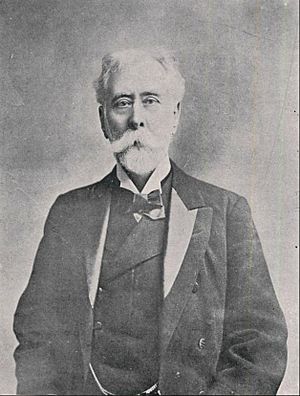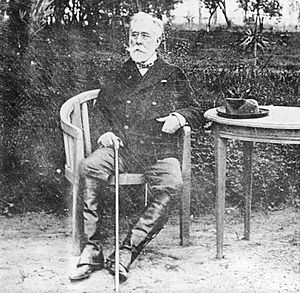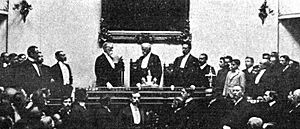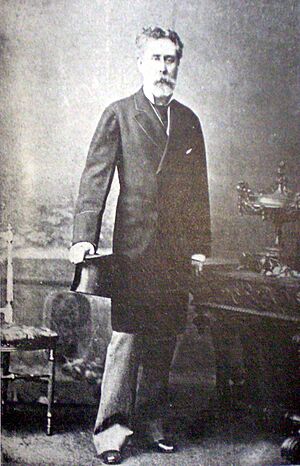Manuel Quintana facts for kids
Quick facts for kids
Manuel Quintana
|
|
|---|---|
 |
|
| President of Argentina | |
| In office October 12, 1904 – March 12, 1906 |
|
| Vice President | José Figueroa Alcorta |
| Preceded by | Julio A. Roca |
| Succeeded by | José Figueroa Alcorta |
| Minister of the Interior | |
| In office October 12, 1892 – December 13, 1892 |
|
| President | Luis Sáenz Peña |
| Preceded by | José Vicente Zapata |
| Succeeded by | Tomás S. de Anchorena |
| In office August 12, 1893 – December 7, 1894 |
|
| President | Luis Sáenz Peña |
| Preceded by | Lucio Vicente López |
| Succeeded by | Eduardo Costa |
| Personal details | |
| Born |
Manuel Pedro Quintana Sáenz
October 19, 1835 Buenos Aires, Argentina |
| Died | March 12, 1906 (aged 70) Buenos Aires, Argentina |
| Resting place | La Recoleta Cemetery Buenos Aires, Argentina |
| Nationality | |
| Political party | National Autonomist Party |
| Spouse | Susana Rodríguez Viana |
| Alma mater | University of Buenos Aires |
| Profession | Lawyer |
| Signature |  |
Manuel Pedro Quintana Sáenz (born October 19, 1835 – died March 12, 1906) was the President of Argentina from October 12, 1904, until his death in office on March 12, 1906.
Contents
Manuel Quintana's Life Story
Manuel Quintana was born in Buenos Aires, Argentina, on October 19, 1835. His parents were Eladio de la Quintana y Uzín and María Manuela Bernardina Sáenz de Gaona y Álzaga.
He studied law at the University of Buenos Aires. By the time he was 20, he had earned his law degree. Just two years later, he was teaching civil law at the same university.
On December 14, 1861, Manuel Quintana married María del Carmen Susana Rodríguez Viana in Buenos Aires. They had ten children together.
His Start in Politics
Manuel Quintana became involved in politics when he was young. In 1860, he was chosen as a deputy for the Province of Buenos Aires. He first joined the party of Bartolomé Mitre.
Later, he switched to the Autonomist Party led by Adolfo Alsina. He did this because he disagreed with Mitre's idea to make the City of Buenos Aires the capital of Argentina.
In 1864, he became a member of the Argentine Chamber of Deputies. He suggested making Rosario the nation's capital. This idea was approved by Congress but was not signed into law by the president.
In 1870, he was elected as a National Senator. The next year, President Sarmiento sent him to Asunción, Paraguay. His job was to help negotiate a peace treaty to end the War of the Triple Alliance.
In 1873, Manuel Quintana ran for president. He wanted to become president after Sarmiento. However, he lost the election to Nicolás Avellaneda.
From 1877 to 1881, he served as the head of the University of Buenos Aires.
Becoming President
Towards the end of Julio A. Roca's second time as president, the National Autonomist Party was split. Roca's group and former president Carlos Pellegrini's group disagreed.
To solve this, Roca decided to team up with Bartolomé Mitre's party. They chose Manuel Quintana, who was from Mitre's party, to run for president. José Figueroa Alcorta, from Roca's group, was chosen as his vice president.
In the election on April 10, 1904, Quintana and Figueroa Alcorta won. They were officially named President and Vice President on June 12, 1904. Manuel Quintana was 68 years old when he became president.
Manuel Quintana's Time as President
Manuel Quintana's presidency was part of a time known as the "Conservative Republic." During this period, the National Autonomist Party was in power.
His government continued many of the policies from the previous presidents. Argentina's economy kept growing. This was helped by more trade and the expansion of the railway system.
Important Actions as President
During his time as president, Manuel Quintana worked on several important things:
- He made the University of La Plata a national university.
- He set rules for how certain jobs, like lawyers and doctors, should be practiced.
- He approved a law for Sunday rest, which meant people got Sundays off work. This idea came from a socialist deputy named Alfredo Palacios.
- He supported the "Lainez Law," which helped create elementary schools in different provinces.
Quintana wanted to improve how elections were done. He suggested a new system where everyone would be registered to vote, and voting would be required. However, his original plan was changed a lot by Congress.
Challenges During His Presidency
In 1905, a group called the Radical Civic Union started a revolution. This uprising happened on February 4 in several cities, including Buenos Aires and Rosario. However, the government quickly stopped it.
On August 11, 1905, Manuel Quintana and his wife, Susana Rodríguez Viana, faced an attack. A man named Salvador Planas y Virella tried to shoot their car. Luckily, his gun did not work. Planas said he acted alone because he was upset about workers who had been hurt in a protest. He was arrested and sentenced to 10 years in prison.
Health and Passing

The stress from the 1905 revolution and the attack on his life affected President Quintana's health. He had to reduce his work hours, which made governing more difficult.
His health continued to get worse. On January 25, 1906, Quintana took a leave of absence. He temporarily gave his duties to Vice President José Figueroa Alcorta. Quintana went to a farm to rest and try to get better.
However, Manuel Quintana was already quite old. He passed away on March 12, 1906. He was the first Argentine president to die while still in office. His remains are buried in the Recoleta Cemetery in Buenos Aires.
His Legacy

Manuel Quintana's picture was once featured on the five hundred thousand austral banknote. This money was used in Argentina between 1989 and 1991.
Images for kids
See also
 In Spanish: Manuel Quintana para niños
In Spanish: Manuel Quintana para niños






